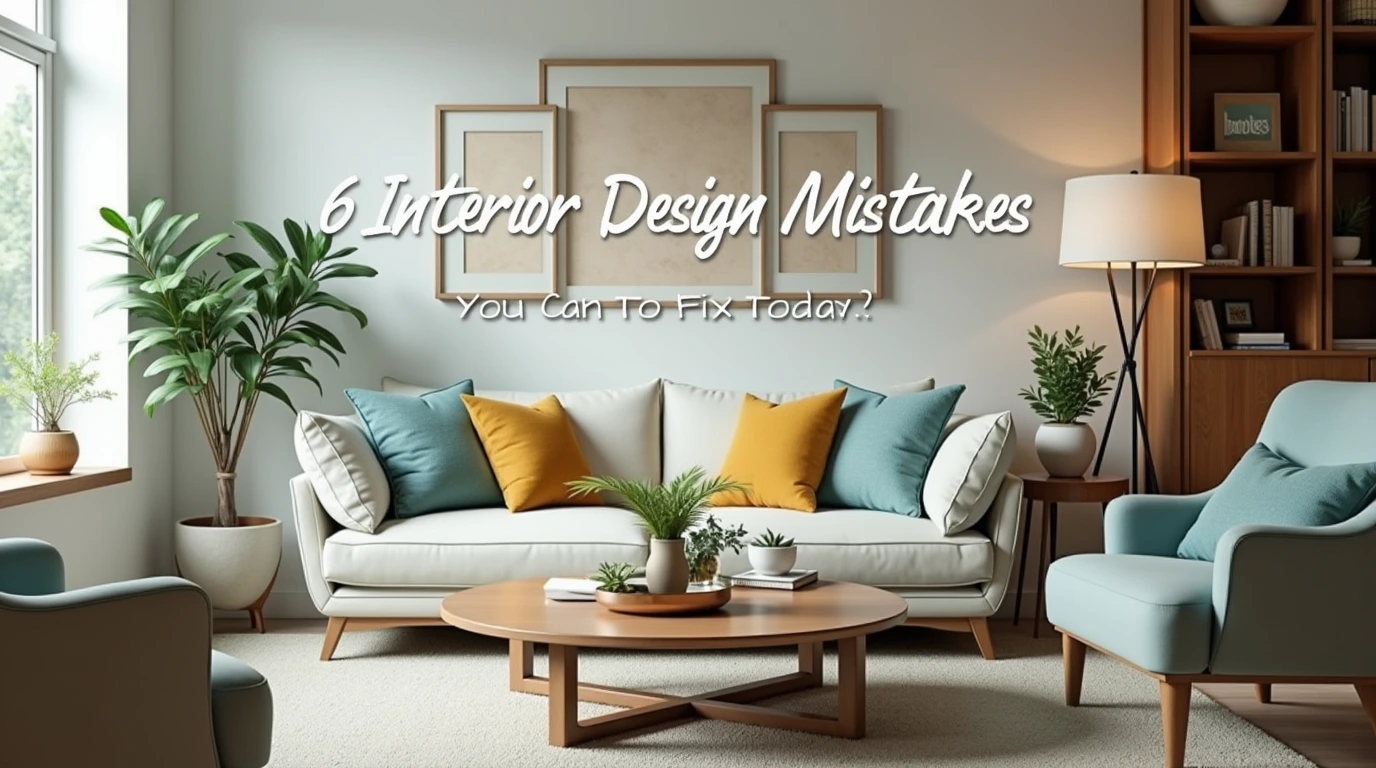Interior Design: 6 Common Mistakes And How To Fix Them
Ever wonder why your room doesn’t feel quite right? Maybe the furniture feels cramped, the colors seem off, or the lighting just isn’t working. Interior design mistakes are more common than you think, and even small missteps can make a space feel unbalanced or uncomfortable.
A well-designed space enhances comfort, functionality, and aesthetics, making it a joy to live in. However, without proper planning, it’s easy to fall into common pitfalls. From poor lighting choices to awkward furniture placement, these mistakes can derail even the best design intentions.
In this post, we’ll highlight six common interior design mistakes and, more importantly, how to fix them. Whether you’re decorating a new home or refreshing your space, these practical solutions will help you achieve a beautiful, functional design.
Why Interior Design Matters
Interior design is more than just choosing pretty furniture and decor—it’s about creating a space that is comfortable, practical, and visually appealing. Good interior design ensures your home not only looks great but also enhances your daily life.
An experienced interior designer understands how to balance aesthetics with function, ensuring that spaces are both stylish and usable. The interior of design encompasses various elements, including lighting, furniture placement, and color schemes, all of which contribute to a harmonious environment.
Mistakes in interior design can lead to spaces that feel cluttered, uninviting, or even impractical. Let’s explore six of the most common design mistakes and how to correct them.
6 Common Mistakes and Fixes
Mistake 1: Ignoring Lighting
Lighting plays a crucial role in interior design, yet it’s often overlooked. Poor lighting can make a space feel dark, unwelcoming, and even smaller than it is.
Fix: Layer different types of lighting—ambient, task, and accent—to create a well-lit, balanced space. Use floor lamps, pendant lights, and natural light to enhance the atmosphere. An interior designer would recommend dimmable options for versatility.
Mistake 2: Poor Furniture Layout
A cramped or awkward furniture arrangement can disrupt the flow of a room, making it feel uncomfortable and cluttered.
Fix: Focus on balance and proportion. Arrange furniture to create clear pathways and define functional areas. In the interior of design, symmetry and spacing are key to achieving a cohesive look.
Mistake 3: Choosing the Wrong Color Scheme
Colors impact mood and perception, yet many homeowners either go too bold or play it too safe, resulting in a lackluster space.
Fix: Choose a balanced color palette. Neutral tones provide flexibility, while accent colors add personality. An interior designer can help select hues that enhance natural light and complement furniture.
Mistake 4: Neglecting Scale and Proportion
Decor that’s too large or too small can make a space feel off. A huge sofa in a small room or tiny decor in a large space disrupts harmony.
Fix: Maintain proportion by mixing different sizes strategically. Large statement pieces should be balanced with smaller elements to create a cohesive interior design.
Mistake 5: Overcrowding with Decor
Too many decorative pieces can make a room feel cluttered and overwhelming, diminishing its visual appeal.
Fix: Embrace minimalism. Select a few statement pieces and ensure every item serves a purpose. A professional interior designer would recommend prioritizing quality over quantity.
Mistake 6: Forgetting Functionality
A beautiful room isn’t truly well-designed if it lacks practicality. Spaces that are purely aesthetic but don’t cater to everyday needs become frustrating.
Fix: Consider your lifestyle when designing your space. Multifunctional furniture, smart storage solutions, and adaptable layouts enhance both form and function in the interior of design.
Pro Tips from Experts
Want to elevate your space even further? Here are a few expert tips:
- Use mirrors strategically to enhance natural light and create an illusion of space.
- Invest in quality over quantity—well-made pieces last longer and enhance interior design.
- Hire an interior designer for large-scale projects to ensure a cohesive and professional look.
- Incorporate texture and layers with rugs, throws, and curtains to add depth to a room.
FAQ: Interior Design Questions Answered
What does an interior designer do?
An interior designer plans and designs functional, aesthetically pleasing spaces. They consider layout, color schemes, furniture, and lighting to create a cohesive design.
What are the 7 basics of interior design?
The 7 principles of interior design are space, line, form, light, color, texture, and pattern. These elements work together to create balance and harmony in a space.
Is interior design a good career?
Yes, interior design is a rewarding career with opportunities in residential, commercial, and hospitality design. It allows for creativity and problem-solving while improving spaces.
Is an interior designer expensive?
The cost of hiring an interior designer varies. Some charge hourly rates, while others work on a flat fee or commission basis. Many designers offer flexible options for different budgets.
Do interior designers make money?
Yes, interior designers can make a good living, especially those with experience or a strong portfolio. Salaries vary based on location, expertise, and clientele.
What skills do interior designers need?
Interior designers need creativity, spatial awareness, attention to detail, communication skills, and knowledge of design principles, materials, and industry software.
Does interior design have a future?
Yes, interior design continues to be in demand as people seek to improve their living and working spaces. Trends evolve, but the need for good design remains constant.
Do interior designers travel a lot?
It depends on the job. Some designers travel frequently for client meetings, site visits, or sourcing materials, while others work primarily from an office.
Is interior design difficult?
Interior design can be challenging, requiring creativity, technical knowledge, and project management skills. However, passion and experience make it a fulfilling profession.
Conclusion
Interior design mistakes can make a space feel off, but with the right approach, they’re easy to fix. By addressing common issues like poor lighting, awkward layouts, and overcrowded decor, you can transform any room into a stylish and functional haven.
Ready to improve your home’s interior design? Start applying these tips today and create a space that truly reflects your style and needs!

